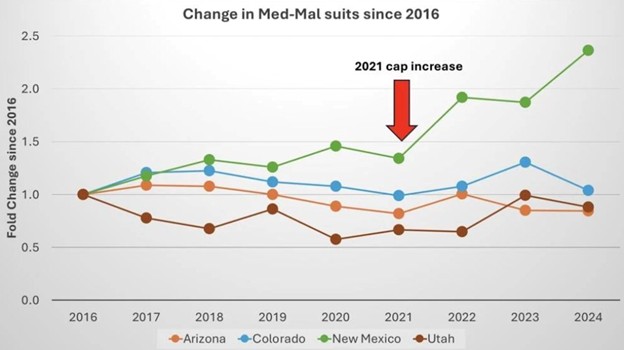Why Do We Have a Physician Shortage
New Mexico has one of the most difficult environments in U.S. for practicing physicians because of the financial challenges. Physicians are stretched to see more patients every day to meet the need for care while facing rising costs and stagnant or declining reimbursement rates that do not cover their costs.
Why Are Doctors Leaving?
New Mexico is a High-Risk Environment for Physicians
Malpractice insurance rates have doubled, sometimes triple the rates in neighboring states since 2021.

Average Malpractice Premiums for Independent Providers
New Mexico Arizona Colorado Utah
$43,020 $23,772 $28,487 $28,861
It’s worse for specialists and hospitals. For example, the minimum yearly cost of malpractice insurance for an OB-GYN in New Mexico is $125,000. The cost in 2021 was $74,000. It shouldn’t be a surprise that NM has lost 22% of our OB-GYN since 2021.
In 2023, Tammie Chavez, Chief Executive Officer at Union County General Hospital was turned down repeatedly by insurance companies who refused to conduct business in New Mexico. When she finally found an insurer, the yearly price tag was $850,000 compared to the previous $143,565 premium.
The cost of malpractice insurance has been identified as one of the most pressing problems facing healthcare in New Mexico.
In her opening statement to the Legislature in 2025, Governor Michelle Lujan Grisham stated that malpractice insurance cost is one of the most pressing problems facing New Mexico. “Health care leaders are clear that the high cost of medical malpractice insurance is the barrier to recruiting and retaining the providers we need.” She went on to say, “Insurance rates for doctors and health care providers shouldn’t be any higher in New Mexico than in neighboring states, and they most certainly shouldn’t be twice the national average.”
Legislation passed in 2021 has created an unbalanced, unnecessarily high-risk environment. New Mexico had the second-largest increase in malpractice premium costs in the nation, according to an American Medical Association study completed in 2023.
Why So Many Lawsuits
Before the changes in the 2021 Malpractice Act, malpractice lawsuits in New Mexico remained relatively flat. Since 2021, cases have increased by 185%. Neighboring states (Colorado, Arizona and Utah) have not had a similar rise.

Why are there so many more lawsuits in New Mexico? Since 2021, punitive damage requests have been threatened in almost every malpractice case filed in New Mexico. These punitive damages are uncapped and not covered by malpractice insurance.
Punitive damages are rarely awarded, but providers risk personal financial devastation if they don’t settle. These extremely serious consequences have two effects:
- They cause doctors to prematurely settle cases that would likely be won if they went to trial; unnecessary settlements contribute to high malpractice insurance premium rates.
- They deter providers from practicing in New Mexico.
A study of 20 years of malpractice payment data in New Mexico showed that only 2.4% of physicians were responsible for half of all the dollars paid for malpractice. Almost 90% of this small group were responsible for multiple payments. Robert Oshel
Associate Director, National Practitioner Data Bank for Research and Disputes Resolution (ret.).
The high cost of malpractice insurance plus the high likelihood of being sued encourages doctors to leave and practice in states with more equitable legal environments and is a discourages physicians from moving to the state.
To learn more: Malpractice insurance costs are hurting rural New Mexico hospitals | Searchlight New Mexico
Financial Burdens
Healthcare providers must balance expenses, just like each of us.
Facility costs, personnel, utilities, insurance, reimbursement rates, and more. In New Mexico, it is a balancing act, in part, because of low reimbursement and gross receipts tax (GRT)
Low Rembursement

After years of training to care for patients, doctors must focus on cash flow. They are struggling to keep their doors open because healthcare providers earn less in New Mexico than in other states. Almost 40% of our citizens rely on Medicaid and almost 30% rely on Medicare. Neither insurance program covers the cost of providing care.
Senate Bill 88, passed by the 2025 legislature, creates a permanent trust fund for Medicaid. The fund will receive recurring revenue until it grows to $2 billion, allowing the state to increase the rates it pays providers to care for Medicaid patients. This is a significant step forward.
Gross Receipts Tax (GRT)
Only two states, New Mexico and Hawaii, impose a GRT on medical services. Businesses pass this cost onto customers. Healthcare providers cannot pass the cost onto insurers or patients. In New Mexico, GRTs vary by city or county and can range from 5% to 9%. The GRT makes health care practice more expensive in New Mexico.
Failure to Participate in the Interstate Medical Licensure Compacts
The quickest way to increase access to healthcare providers in New Mexico is to join the Interstate health care compacts.
The state’s physician-to-patient ratio is one of the worst in the country, people are waiting sometimes years to establish primary care providers and rural New Mexicans and patients needing specialty care are worse off.
Compacts are agreements between states to recognize medical licenses issued by other states. The goal is to address physician shortages and improve access to healthcare, especially in underserved areas and through telemedicine.
Each state retains the right to refuse to recognize a license issued by another state. Participating states have access to a centralized database of disciplinary action records.
Participating providers are subject to all of the state’s rules, including medical malpractice and insurance requirements.
There are ten major health care compacts. Thirty-one states have adopted eight compacts. All states surrounding New Mexico have adopted at least five of the compacts, including the physician compact.

New Mexico has joined one: the Nurse Licensure Compact. New Mexico joined forty states and granted nurses the privilege to practice in other compact states in 2003. As many as 80% of the nurses working in New Mexico hospitals, especially in rural and border areas, can practice here because of the Compact.
What does New Mexico’s failure to join the Interstate Medical Licensure Compact mean you? It means that if you or a family member needs a healthcare provider that is unavailable in New Mexico, you must travel to another state to access care, if you are able to do so.
“I have chronic Lyme disease. I did not think twice about moving to New Mexico expecting to continue my treatment here. When I couldn’t find a specialist who could continue my treatment, I decided I would continue with my Colorado specialist through tele-health and occasional trips back to Denver. Unfortunately, my Colorado specialist could not use tele-health consultations because he is not licensed in New Mexico and New Mexico does not participate in the interstate compact.”